Auditing and Assurance Services
VerifiedAdded on 2023/06/13
|12
|3076
|79
AI Summary
This article discusses the need for business entities to audit their sustainability reports, with a focus on GHG reporting and NGER audit requirements. It also analyzes the sustainability reports of Woodside Petroleum Limited and AGL Energy Limited. Additionally, it covers a case scenario involving the negligence of auditors while auditing the financial statements of CFW, a distributor and warehousing facility for chemicals and fertilizer, and the legal action taken by Warehousing Ltd against the auditors.
Contribute Materials
Your contribution can guide someone’s learning journey. Share your
documents today.
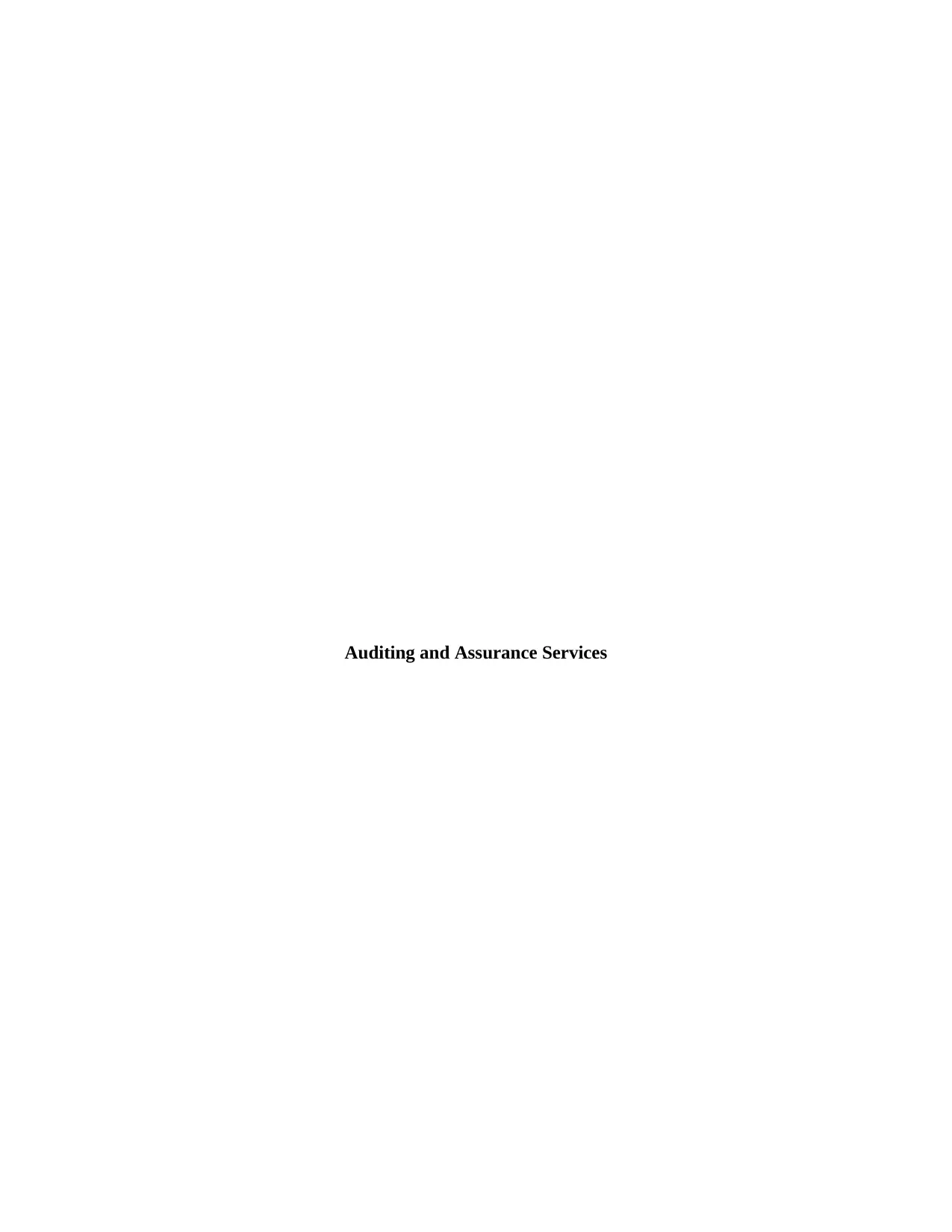
Auditing and Assurance Services
Secure Best Marks with AI Grader
Need help grading? Try our AI Grader for instant feedback on your assignments.
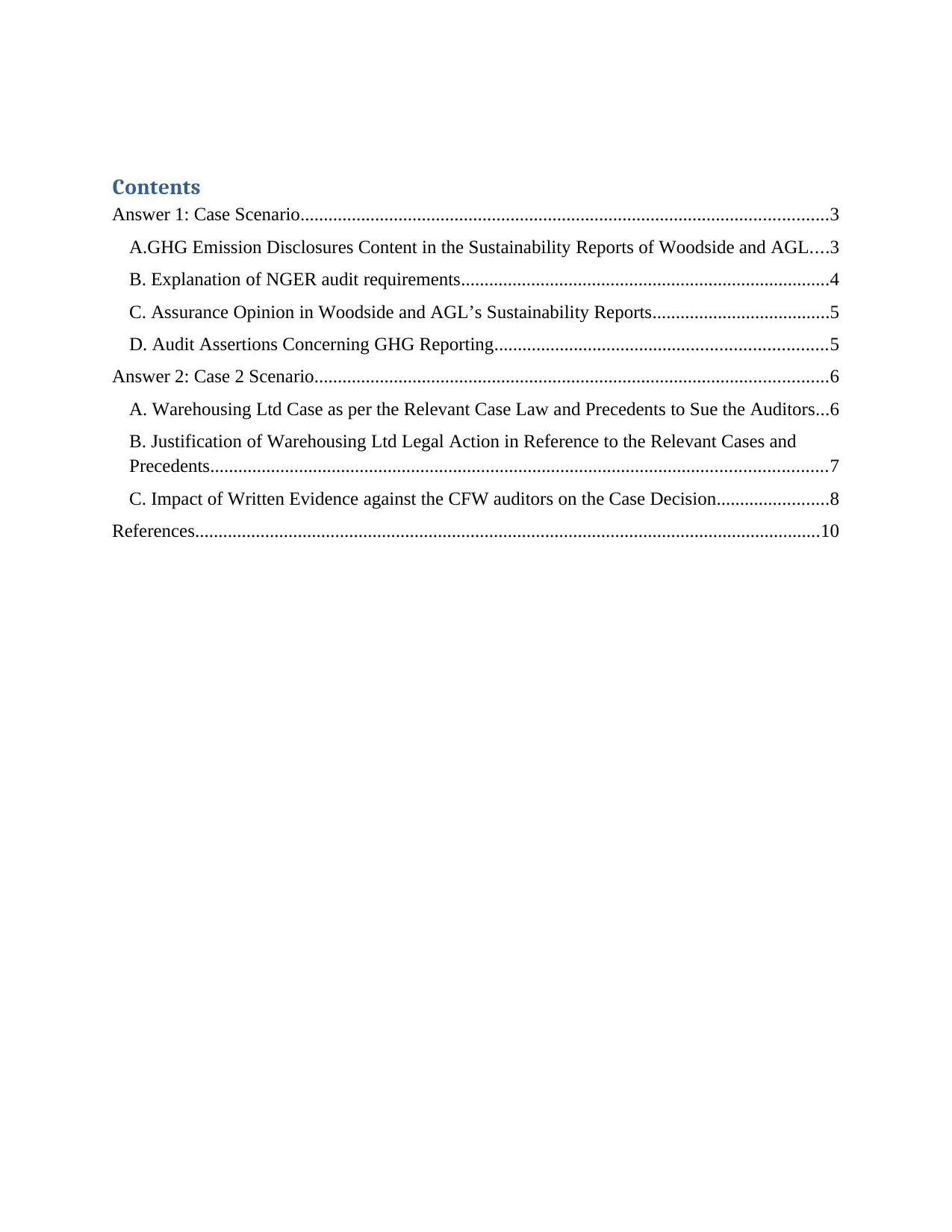
Contents
Answer 1: Case Scenario.................................................................................................................3
A.GHG Emission Disclosures Content in the Sustainability Reports of Woodside and AGL....3
B. Explanation of NGER audit requirements...............................................................................4
C. Assurance Opinion in Woodside and AGL’s Sustainability Reports......................................5
D. Audit Assertions Concerning GHG Reporting.......................................................................5
Answer 2: Case 2 Scenario..............................................................................................................6
A. Warehousing Ltd Case as per the Relevant Case Law and Precedents to Sue the Auditors...6
B. Justification of Warehousing Ltd Legal Action in Reference to the Relevant Cases and
Precedents....................................................................................................................................7
C. Impact of Written Evidence against the CFW auditors on the Case Decision........................8
References......................................................................................................................................10
Answer 1: Case Scenario.................................................................................................................3
A.GHG Emission Disclosures Content in the Sustainability Reports of Woodside and AGL....3
B. Explanation of NGER audit requirements...............................................................................4
C. Assurance Opinion in Woodside and AGL’s Sustainability Reports......................................5
D. Audit Assertions Concerning GHG Reporting.......................................................................5
Answer 2: Case 2 Scenario..............................................................................................................6
A. Warehousing Ltd Case as per the Relevant Case Law and Precedents to Sue the Auditors...6
B. Justification of Warehousing Ltd Legal Action in Reference to the Relevant Cases and
Precedents....................................................................................................................................7
C. Impact of Written Evidence against the CFW auditors on the Case Decision........................8
References......................................................................................................................................10
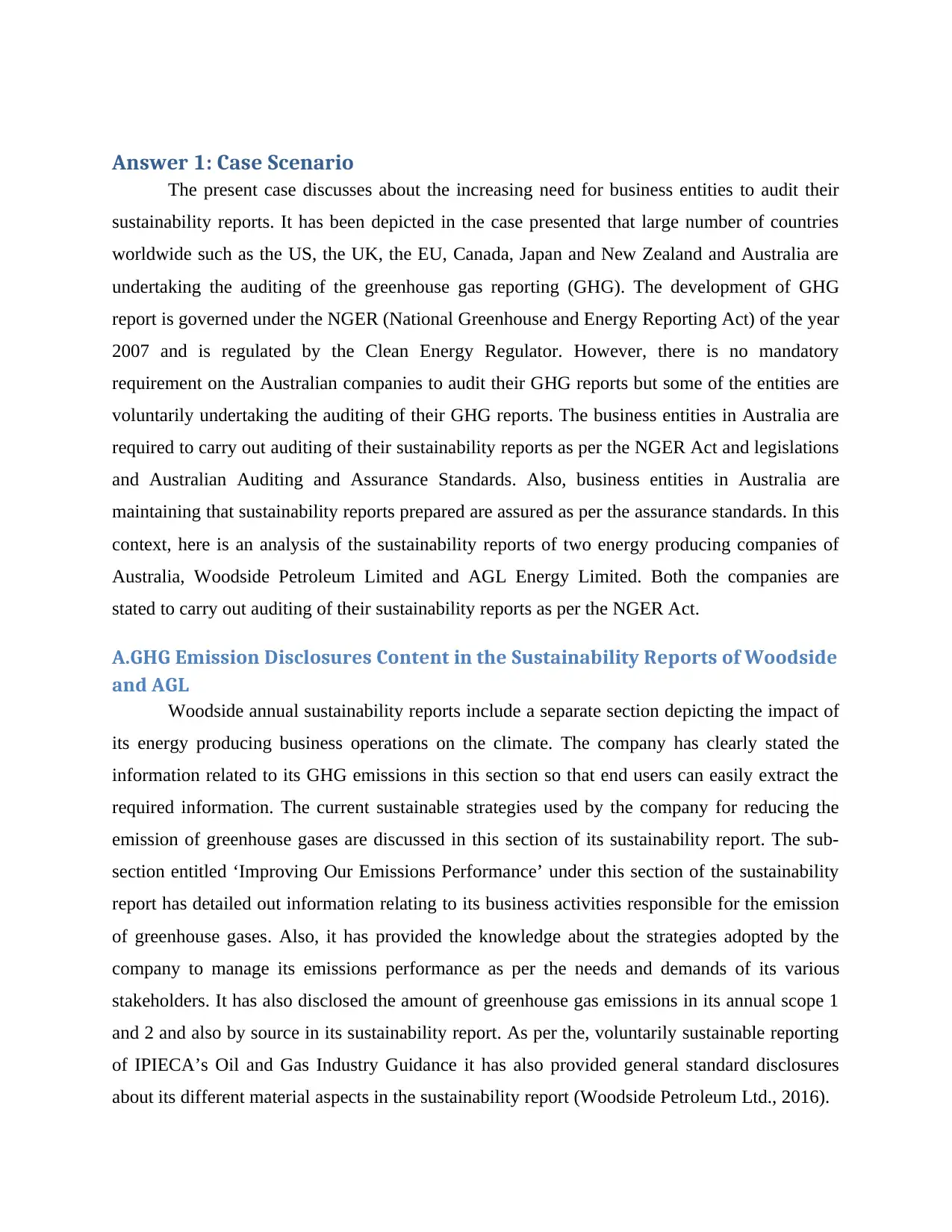
Answer 1: Case Scenario
The present case discusses about the increasing need for business entities to audit their
sustainability reports. It has been depicted in the case presented that large number of countries
worldwide such as the US, the UK, the EU, Canada, Japan and New Zealand and Australia are
undertaking the auditing of the greenhouse gas reporting (GHG). The development of GHG
report is governed under the NGER (National Greenhouse and Energy Reporting Act) of the year
2007 and is regulated by the Clean Energy Regulator. However, there is no mandatory
requirement on the Australian companies to audit their GHG reports but some of the entities are
voluntarily undertaking the auditing of their GHG reports. The business entities in Australia are
required to carry out auditing of their sustainability reports as per the NGER Act and legislations
and Australian Auditing and Assurance Standards. Also, business entities in Australia are
maintaining that sustainability reports prepared are assured as per the assurance standards. In this
context, here is an analysis of the sustainability reports of two energy producing companies of
Australia, Woodside Petroleum Limited and AGL Energy Limited. Both the companies are
stated to carry out auditing of their sustainability reports as per the NGER Act.
A.GHG Emission Disclosures Content in the Sustainability Reports of Woodside
and AGL
Woodside annual sustainability reports include a separate section depicting the impact of
its energy producing business operations on the climate. The company has clearly stated the
information related to its GHG emissions in this section so that end users can easily extract the
required information. The current sustainable strategies used by the company for reducing the
emission of greenhouse gases are discussed in this section of its sustainability report. The sub-
section entitled ‘Improving Our Emissions Performance’ under this section of the sustainability
report has detailed out information relating to its business activities responsible for the emission
of greenhouse gases. Also, it has provided the knowledge about the strategies adopted by the
company to manage its emissions performance as per the needs and demands of its various
stakeholders. It has also disclosed the amount of greenhouse gas emissions in its annual scope 1
and 2 and also by source in its sustainability report. As per the, voluntarily sustainable reporting
of IPIECA’s Oil and Gas Industry Guidance it has also provided general standard disclosures
about its different material aspects in the sustainability report (Woodside Petroleum Ltd., 2016).
The present case discusses about the increasing need for business entities to audit their
sustainability reports. It has been depicted in the case presented that large number of countries
worldwide such as the US, the UK, the EU, Canada, Japan and New Zealand and Australia are
undertaking the auditing of the greenhouse gas reporting (GHG). The development of GHG
report is governed under the NGER (National Greenhouse and Energy Reporting Act) of the year
2007 and is regulated by the Clean Energy Regulator. However, there is no mandatory
requirement on the Australian companies to audit their GHG reports but some of the entities are
voluntarily undertaking the auditing of their GHG reports. The business entities in Australia are
required to carry out auditing of their sustainability reports as per the NGER Act and legislations
and Australian Auditing and Assurance Standards. Also, business entities in Australia are
maintaining that sustainability reports prepared are assured as per the assurance standards. In this
context, here is an analysis of the sustainability reports of two energy producing companies of
Australia, Woodside Petroleum Limited and AGL Energy Limited. Both the companies are
stated to carry out auditing of their sustainability reports as per the NGER Act.
A.GHG Emission Disclosures Content in the Sustainability Reports of Woodside
and AGL
Woodside annual sustainability reports include a separate section depicting the impact of
its energy producing business operations on the climate. The company has clearly stated the
information related to its GHG emissions in this section so that end users can easily extract the
required information. The current sustainable strategies used by the company for reducing the
emission of greenhouse gases are discussed in this section of its sustainability report. The sub-
section entitled ‘Improving Our Emissions Performance’ under this section of the sustainability
report has detailed out information relating to its business activities responsible for the emission
of greenhouse gases. Also, it has provided the knowledge about the strategies adopted by the
company to manage its emissions performance as per the needs and demands of its various
stakeholders. It has also disclosed the amount of greenhouse gas emissions in its annual scope 1
and 2 and also by source in its sustainability report. As per the, voluntarily sustainable reporting
of IPIECA’s Oil and Gas Industry Guidance it has also provided general standard disclosures
about its different material aspects in the sustainability report (Woodside Petroleum Ltd., 2016).
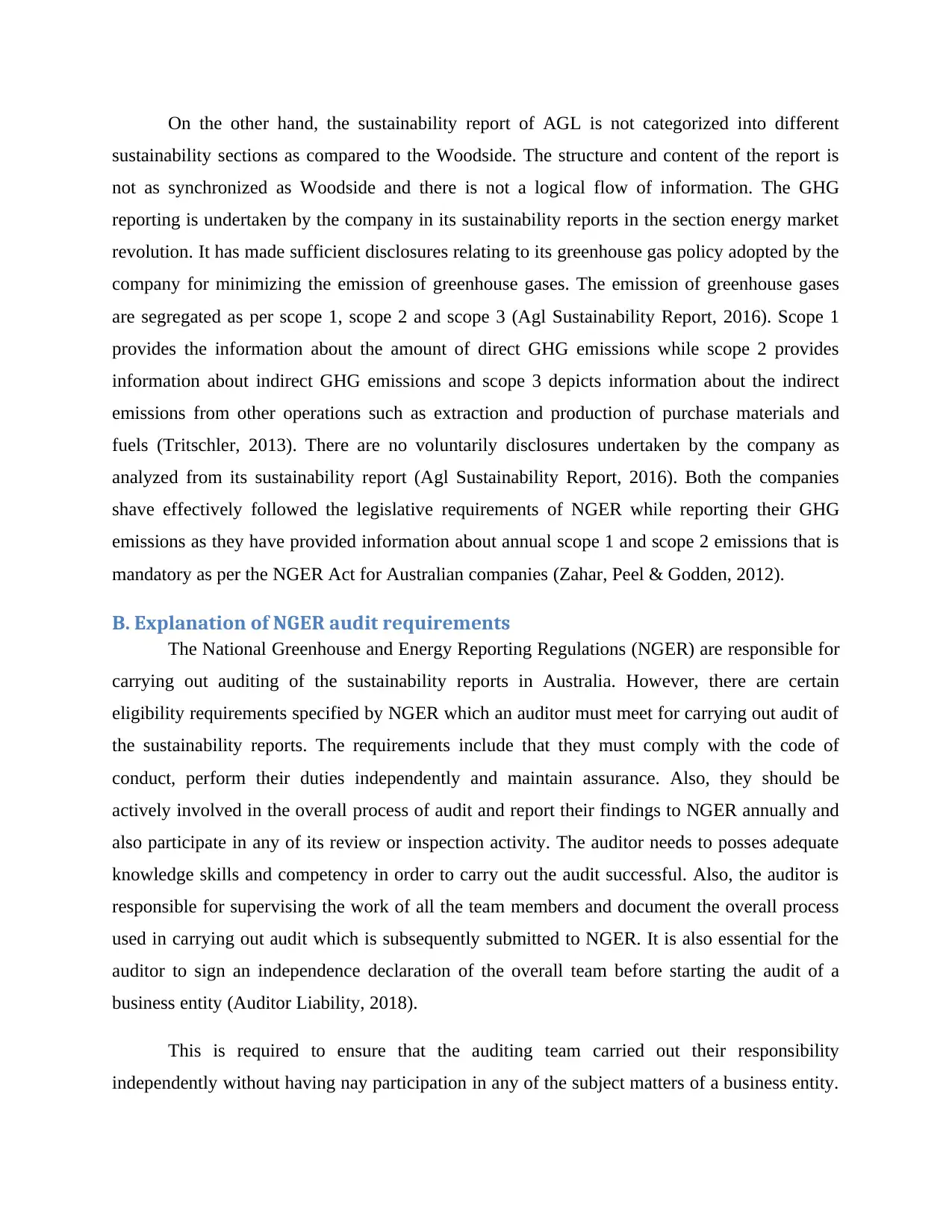
On the other hand, the sustainability report of AGL is not categorized into different
sustainability sections as compared to the Woodside. The structure and content of the report is
not as synchronized as Woodside and there is not a logical flow of information. The GHG
reporting is undertaken by the company in its sustainability reports in the section energy market
revolution. It has made sufficient disclosures relating to its greenhouse gas policy adopted by the
company for minimizing the emission of greenhouse gases. The emission of greenhouse gases
are segregated as per scope 1, scope 2 and scope 3 (Agl Sustainability Report, 2016). Scope 1
provides the information about the amount of direct GHG emissions while scope 2 provides
information about indirect GHG emissions and scope 3 depicts information about the indirect
emissions from other operations such as extraction and production of purchase materials and
fuels (Tritschler, 2013). There are no voluntarily disclosures undertaken by the company as
analyzed from its sustainability report (Agl Sustainability Report, 2016). Both the companies
shave effectively followed the legislative requirements of NGER while reporting their GHG
emissions as they have provided information about annual scope 1 and scope 2 emissions that is
mandatory as per the NGER Act for Australian companies (Zahar, Peel & Godden, 2012).
B. Explanation of NGER audit requirements
The National Greenhouse and Energy Reporting Regulations (NGER) are responsible for
carrying out auditing of the sustainability reports in Australia. However, there are certain
eligibility requirements specified by NGER which an auditor must meet for carrying out audit of
the sustainability reports. The requirements include that they must comply with the code of
conduct, perform their duties independently and maintain assurance. Also, they should be
actively involved in the overall process of audit and report their findings to NGER annually and
also participate in any of its review or inspection activity. The auditor needs to posses adequate
knowledge skills and competency in order to carry out the audit successful. Also, the auditor is
responsible for supervising the work of all the team members and document the overall process
used in carrying out audit which is subsequently submitted to NGER. It is also essential for the
auditor to sign an independence declaration of the overall team before starting the audit of a
business entity (Auditor Liability, 2018).
This is required to ensure that the auditing team carried out their responsibility
independently without having nay participation in any of the subject matters of a business entity.
sustainability sections as compared to the Woodside. The structure and content of the report is
not as synchronized as Woodside and there is not a logical flow of information. The GHG
reporting is undertaken by the company in its sustainability reports in the section energy market
revolution. It has made sufficient disclosures relating to its greenhouse gas policy adopted by the
company for minimizing the emission of greenhouse gases. The emission of greenhouse gases
are segregated as per scope 1, scope 2 and scope 3 (Agl Sustainability Report, 2016). Scope 1
provides the information about the amount of direct GHG emissions while scope 2 provides
information about indirect GHG emissions and scope 3 depicts information about the indirect
emissions from other operations such as extraction and production of purchase materials and
fuels (Tritschler, 2013). There are no voluntarily disclosures undertaken by the company as
analyzed from its sustainability report (Agl Sustainability Report, 2016). Both the companies
shave effectively followed the legislative requirements of NGER while reporting their GHG
emissions as they have provided information about annual scope 1 and scope 2 emissions that is
mandatory as per the NGER Act for Australian companies (Zahar, Peel & Godden, 2012).
B. Explanation of NGER audit requirements
The National Greenhouse and Energy Reporting Regulations (NGER) are responsible for
carrying out auditing of the sustainability reports in Australia. However, there are certain
eligibility requirements specified by NGER which an auditor must meet for carrying out audit of
the sustainability reports. The requirements include that they must comply with the code of
conduct, perform their duties independently and maintain assurance. Also, they should be
actively involved in the overall process of audit and report their findings to NGER annually and
also participate in any of its review or inspection activity. The auditor needs to posses adequate
knowledge skills and competency in order to carry out the audit successful. Also, the auditor is
responsible for supervising the work of all the team members and document the overall process
used in carrying out audit which is subsequently submitted to NGER. It is also essential for the
auditor to sign an independence declaration of the overall team before starting the audit of a
business entity (Auditor Liability, 2018).
This is required to ensure that the auditing team carried out their responsibility
independently without having nay participation in any of the subject matters of a business entity.
Paraphrase This Document
Need a fresh take? Get an instant paraphrase of this document with our AI Paraphraser
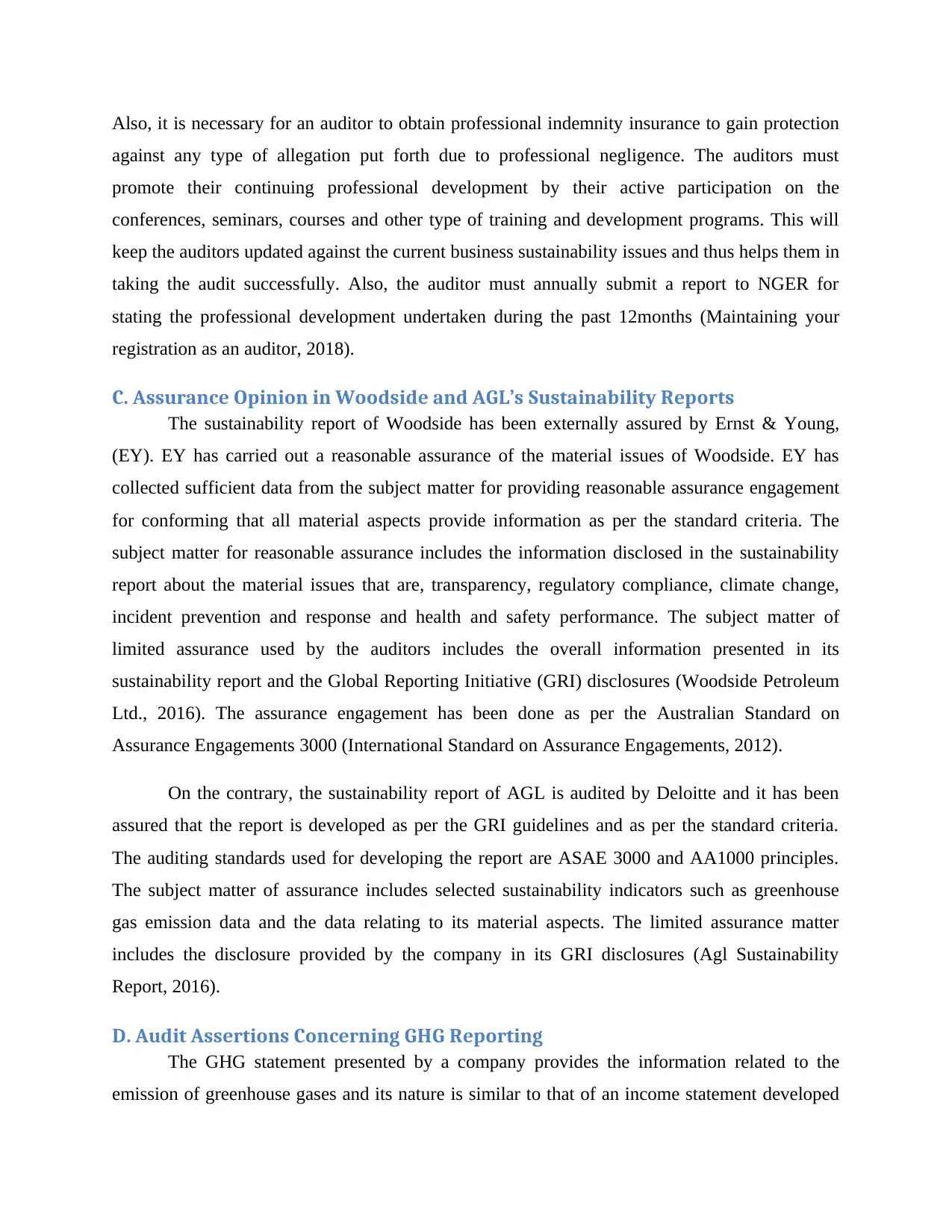
Also, it is necessary for an auditor to obtain professional indemnity insurance to gain protection
against any type of allegation put forth due to professional negligence. The auditors must
promote their continuing professional development by their active participation on the
conferences, seminars, courses and other type of training and development programs. This will
keep the auditors updated against the current business sustainability issues and thus helps them in
taking the audit successfully. Also, the auditor must annually submit a report to NGER for
stating the professional development undertaken during the past 12months (Maintaining your
registration as an auditor, 2018).
C. Assurance Opinion in Woodside and AGL’s Sustainability Reports
The sustainability report of Woodside has been externally assured by Ernst & Young,
(EY). EY has carried out a reasonable assurance of the material issues of Woodside. EY has
collected sufficient data from the subject matter for providing reasonable assurance engagement
for conforming that all material aspects provide information as per the standard criteria. The
subject matter for reasonable assurance includes the information disclosed in the sustainability
report about the material issues that are, transparency, regulatory compliance, climate change,
incident prevention and response and health and safety performance. The subject matter of
limited assurance used by the auditors includes the overall information presented in its
sustainability report and the Global Reporting Initiative (GRI) disclosures (Woodside Petroleum
Ltd., 2016). The assurance engagement has been done as per the Australian Standard on
Assurance Engagements 3000 (International Standard on Assurance Engagements, 2012).
On the contrary, the sustainability report of AGL is audited by Deloitte and it has been
assured that the report is developed as per the GRI guidelines and as per the standard criteria.
The auditing standards used for developing the report are ASAE 3000 and AA1000 principles.
The subject matter of assurance includes selected sustainability indicators such as greenhouse
gas emission data and the data relating to its material aspects. The limited assurance matter
includes the disclosure provided by the company in its GRI disclosures (Agl Sustainability
Report, 2016).
D. Audit Assertions Concerning GHG Reporting
The GHG statement presented by a company provides the information related to the
emission of greenhouse gases and its nature is similar to that of an income statement developed
against any type of allegation put forth due to professional negligence. The auditors must
promote their continuing professional development by their active participation on the
conferences, seminars, courses and other type of training and development programs. This will
keep the auditors updated against the current business sustainability issues and thus helps them in
taking the audit successfully. Also, the auditor must annually submit a report to NGER for
stating the professional development undertaken during the past 12months (Maintaining your
registration as an auditor, 2018).
C. Assurance Opinion in Woodside and AGL’s Sustainability Reports
The sustainability report of Woodside has been externally assured by Ernst & Young,
(EY). EY has carried out a reasonable assurance of the material issues of Woodside. EY has
collected sufficient data from the subject matter for providing reasonable assurance engagement
for conforming that all material aspects provide information as per the standard criteria. The
subject matter for reasonable assurance includes the information disclosed in the sustainability
report about the material issues that are, transparency, regulatory compliance, climate change,
incident prevention and response and health and safety performance. The subject matter of
limited assurance used by the auditors includes the overall information presented in its
sustainability report and the Global Reporting Initiative (GRI) disclosures (Woodside Petroleum
Ltd., 2016). The assurance engagement has been done as per the Australian Standard on
Assurance Engagements 3000 (International Standard on Assurance Engagements, 2012).
On the contrary, the sustainability report of AGL is audited by Deloitte and it has been
assured that the report is developed as per the GRI guidelines and as per the standard criteria.
The auditing standards used for developing the report are ASAE 3000 and AA1000 principles.
The subject matter of assurance includes selected sustainability indicators such as greenhouse
gas emission data and the data relating to its material aspects. The limited assurance matter
includes the disclosure provided by the company in its GRI disclosures (Agl Sustainability
Report, 2016).
D. Audit Assertions Concerning GHG Reporting
The GHG statement presented by a company provides the information related to the
emission of greenhouse gases and its nature is similar to that of an income statement developed

presenting the financial information. As such, the audit assertions that are used for GHG
reporting is completeness of material information provided by a company in its sustainability
report. This is because the subject matter of engagement used by the auditors relies on the
complete and accurate information provided by the company in its key material aspects in the
sustainability report. Also, it is also asserted that the auditors posses necessary competencies and
knowledge to carry out the audit as per the assurance standards. It has been assumed that the
audit is carried out to the very bets of knowledge of auditors and thus the information presented
by a company is reasonable assured as per the assurance standards (Bellassen & Stephan, 2015).
Answer 2: Case 2 Scenario
The given case is about the negligence of auditors while auditing the financial statements.
CFW, a distributor and warehousing facility for chemicals and fertilizer was reported to have a
higher level of inventory in its audited financial statements during the time of its takeover by
Warehousing Ltd. However, it has been identified by Warehousing Ltd that the inventories were
stated to be overvalued in its audited financial statements. As such, Warehousing Ltd is planning
to sue the auditors for negligence that they had taken while developing the audited financial
statements. The following matters were brought before the court in the case that the auditors
have not taken all the stocktakes at the end of the year. Also, the inventory of the company has
been overvalued by 35% in its Sydney based operations. The auditors have accepted in this
regard that it is the management’s valuation that did not take into account the considerable
obsolescence. Also, it has been established that 50% of the inventory of the company is held at
its Bathurst facility and the inventory does not have any existence. The auditors have accepted in
their part that they were under pressure to complete the audit by the management of CFW to
complete the audit within one month. However, there is no evidence by Warehousing Ltd that
they were aware of the fact that the auditors were aware of the intended use of the accounts.
A. Warehousing Ltd Case as per the Relevant Case Law and Precedents to Sue
the Auditors
The case of Warehousing Ltd to sue the auditors can be based on the fact that auditors are
potentially liable for both criminal and civil offences. Under the criminal offences, the auditors
are subjected to legislation under the state as stated in the Companies Act 2006. This would
provide enough detail for Warehousing Ltd about their functions and responsibility. Under the
reporting is completeness of material information provided by a company in its sustainability
report. This is because the subject matter of engagement used by the auditors relies on the
complete and accurate information provided by the company in its key material aspects in the
sustainability report. Also, it is also asserted that the auditors posses necessary competencies and
knowledge to carry out the audit as per the assurance standards. It has been assumed that the
audit is carried out to the very bets of knowledge of auditors and thus the information presented
by a company is reasonable assured as per the assurance standards (Bellassen & Stephan, 2015).
Answer 2: Case 2 Scenario
The given case is about the negligence of auditors while auditing the financial statements.
CFW, a distributor and warehousing facility for chemicals and fertilizer was reported to have a
higher level of inventory in its audited financial statements during the time of its takeover by
Warehousing Ltd. However, it has been identified by Warehousing Ltd that the inventories were
stated to be overvalued in its audited financial statements. As such, Warehousing Ltd is planning
to sue the auditors for negligence that they had taken while developing the audited financial
statements. The following matters were brought before the court in the case that the auditors
have not taken all the stocktakes at the end of the year. Also, the inventory of the company has
been overvalued by 35% in its Sydney based operations. The auditors have accepted in this
regard that it is the management’s valuation that did not take into account the considerable
obsolescence. Also, it has been established that 50% of the inventory of the company is held at
its Bathurst facility and the inventory does not have any existence. The auditors have accepted in
their part that they were under pressure to complete the audit by the management of CFW to
complete the audit within one month. However, there is no evidence by Warehousing Ltd that
they were aware of the fact that the auditors were aware of the intended use of the accounts.
A. Warehousing Ltd Case as per the Relevant Case Law and Precedents to Sue
the Auditors
The case of Warehousing Ltd to sue the auditors can be based on the fact that auditors are
potentially liable for both criminal and civil offences. Under the criminal offences, the auditors
are subjected to legislation under the state as stated in the Companies Act 2006. This would
provide enough detail for Warehousing Ltd about their functions and responsibility. Under the
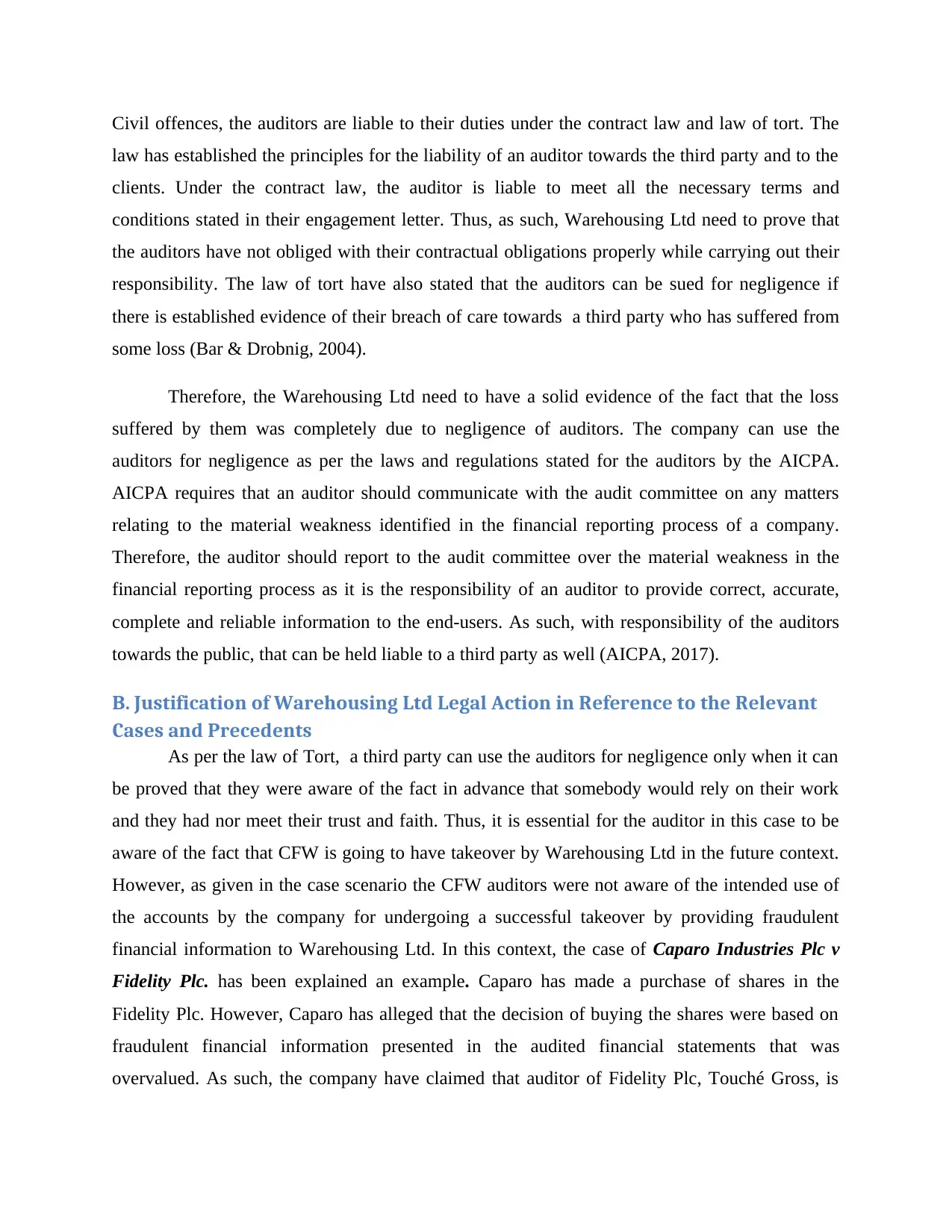
Civil offences, the auditors are liable to their duties under the contract law and law of tort. The
law has established the principles for the liability of an auditor towards the third party and to the
clients. Under the contract law, the auditor is liable to meet all the necessary terms and
conditions stated in their engagement letter. Thus, as such, Warehousing Ltd need to prove that
the auditors have not obliged with their contractual obligations properly while carrying out their
responsibility. The law of tort have also stated that the auditors can be sued for negligence if
there is established evidence of their breach of care towards a third party who has suffered from
some loss (Bar & Drobnig, 2004).
Therefore, the Warehousing Ltd need to have a solid evidence of the fact that the loss
suffered by them was completely due to negligence of auditors. The company can use the
auditors for negligence as per the laws and regulations stated for the auditors by the AICPA.
AICPA requires that an auditor should communicate with the audit committee on any matters
relating to the material weakness identified in the financial reporting process of a company.
Therefore, the auditor should report to the audit committee over the material weakness in the
financial reporting process as it is the responsibility of an auditor to provide correct, accurate,
complete and reliable information to the end-users. As such, with responsibility of the auditors
towards the public, that can be held liable to a third party as well (AICPA, 2017).
B. Justification of Warehousing Ltd Legal Action in Reference to the Relevant
Cases and Precedents
As per the law of Tort, a third party can use the auditors for negligence only when it can
be proved that they were aware of the fact in advance that somebody would rely on their work
and they had nor meet their trust and faith. Thus, it is essential for the auditor in this case to be
aware of the fact that CFW is going to have takeover by Warehousing Ltd in the future context.
However, as given in the case scenario the CFW auditors were not aware of the intended use of
the accounts by the company for undergoing a successful takeover by providing fraudulent
financial information to Warehousing Ltd. In this context, the case of Caparo Industries Plc v
Fidelity Plc. has been explained an example. Caparo has made a purchase of shares in the
Fidelity Plc. However, Caparo has alleged that the decision of buying the shares were based on
fraudulent financial information presented in the audited financial statements that was
overvalued. As such, the company have claimed that auditor of Fidelity Plc, Touché Gross, is
law has established the principles for the liability of an auditor towards the third party and to the
clients. Under the contract law, the auditor is liable to meet all the necessary terms and
conditions stated in their engagement letter. Thus, as such, Warehousing Ltd need to prove that
the auditors have not obliged with their contractual obligations properly while carrying out their
responsibility. The law of tort have also stated that the auditors can be sued for negligence if
there is established evidence of their breach of care towards a third party who has suffered from
some loss (Bar & Drobnig, 2004).
Therefore, the Warehousing Ltd need to have a solid evidence of the fact that the loss
suffered by them was completely due to negligence of auditors. The company can use the
auditors for negligence as per the laws and regulations stated for the auditors by the AICPA.
AICPA requires that an auditor should communicate with the audit committee on any matters
relating to the material weakness identified in the financial reporting process of a company.
Therefore, the auditor should report to the audit committee over the material weakness in the
financial reporting process as it is the responsibility of an auditor to provide correct, accurate,
complete and reliable information to the end-users. As such, with responsibility of the auditors
towards the public, that can be held liable to a third party as well (AICPA, 2017).
B. Justification of Warehousing Ltd Legal Action in Reference to the Relevant
Cases and Precedents
As per the law of Tort, a third party can use the auditors for negligence only when it can
be proved that they were aware of the fact in advance that somebody would rely on their work
and they had nor meet their trust and faith. Thus, it is essential for the auditor in this case to be
aware of the fact that CFW is going to have takeover by Warehousing Ltd in the future context.
However, as given in the case scenario the CFW auditors were not aware of the intended use of
the accounts by the company for undergoing a successful takeover by providing fraudulent
financial information to Warehousing Ltd. In this context, the case of Caparo Industries Plc v
Fidelity Plc. has been explained an example. Caparo has made a purchase of shares in the
Fidelity Plc. However, Caparo has alleged that the decision of buying the shares were based on
fraudulent financial information presented in the audited financial statements that was
overvalued. As such, the company have claimed that auditor of Fidelity Plc, Touché Gross, is
Secure Best Marks with AI Grader
Need help grading? Try our AI Grader for instant feedback on your assignments.
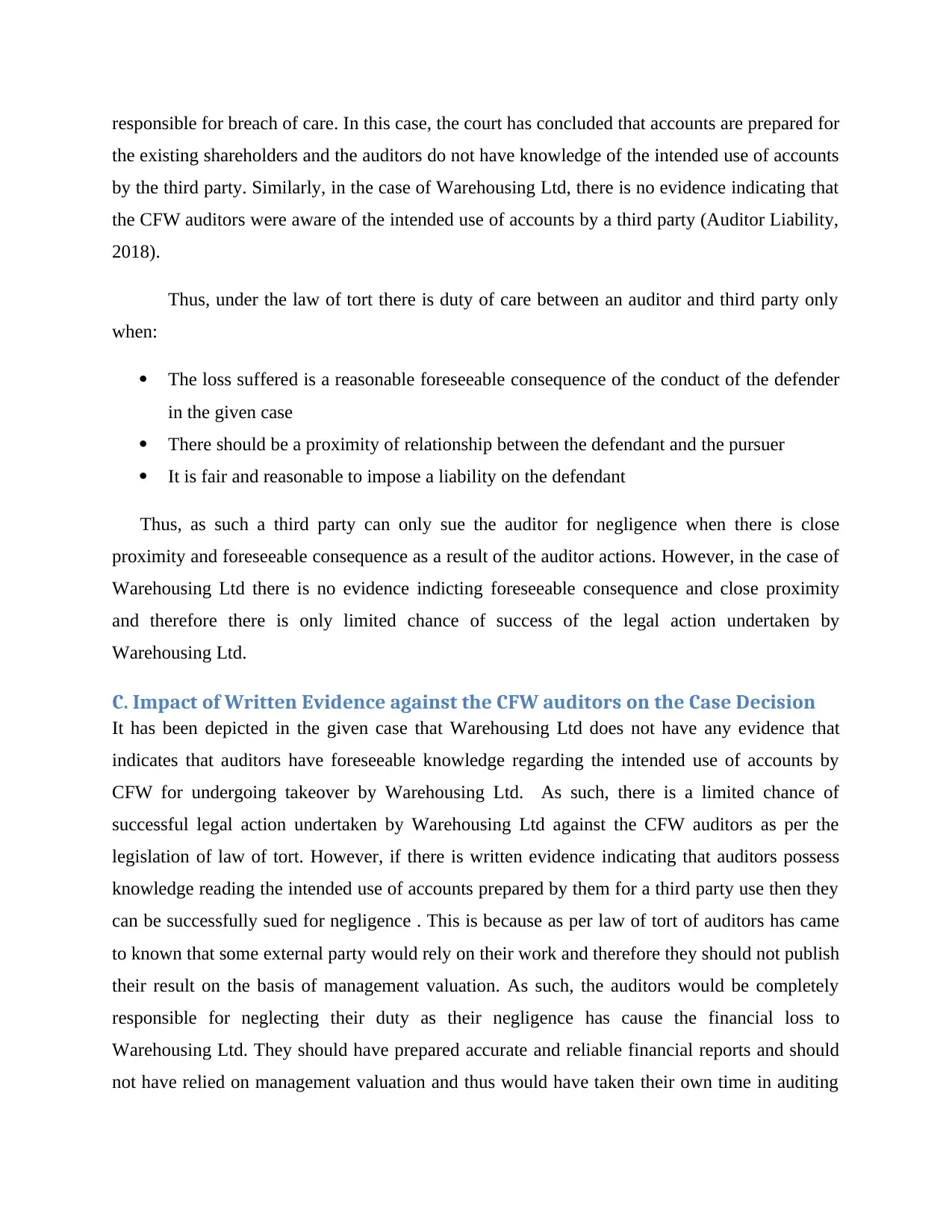
responsible for breach of care. In this case, the court has concluded that accounts are prepared for
the existing shareholders and the auditors do not have knowledge of the intended use of accounts
by the third party. Similarly, in the case of Warehousing Ltd, there is no evidence indicating that
the CFW auditors were aware of the intended use of accounts by a third party (Auditor Liability,
2018).
Thus, under the law of tort there is duty of care between an auditor and third party only
when:
The loss suffered is a reasonable foreseeable consequence of the conduct of the defender
in the given case
There should be a proximity of relationship between the defendant and the pursuer
It is fair and reasonable to impose a liability on the defendant
Thus, as such a third party can only sue the auditor for negligence when there is close
proximity and foreseeable consequence as a result of the auditor actions. However, in the case of
Warehousing Ltd there is no evidence indicting foreseeable consequence and close proximity
and therefore there is only limited chance of success of the legal action undertaken by
Warehousing Ltd.
C. Impact of Written Evidence against the CFW auditors on the Case Decision
It has been depicted in the given case that Warehousing Ltd does not have any evidence that
indicates that auditors have foreseeable knowledge regarding the intended use of accounts by
CFW for undergoing takeover by Warehousing Ltd. As such, there is a limited chance of
successful legal action undertaken by Warehousing Ltd against the CFW auditors as per the
legislation of law of tort. However, if there is written evidence indicating that auditors possess
knowledge reading the intended use of accounts prepared by them for a third party use then they
can be successfully sued for negligence . This is because as per law of tort of auditors has came
to known that some external party would rely on their work and therefore they should not publish
their result on the basis of management valuation. As such, the auditors would be completely
responsible for neglecting their duty as their negligence has cause the financial loss to
Warehousing Ltd. They should have prepared accurate and reliable financial reports and should
not have relied on management valuation and thus would have taken their own time in auditing
the existing shareholders and the auditors do not have knowledge of the intended use of accounts
by the third party. Similarly, in the case of Warehousing Ltd, there is no evidence indicating that
the CFW auditors were aware of the intended use of accounts by a third party (Auditor Liability,
2018).
Thus, under the law of tort there is duty of care between an auditor and third party only
when:
The loss suffered is a reasonable foreseeable consequence of the conduct of the defender
in the given case
There should be a proximity of relationship between the defendant and the pursuer
It is fair and reasonable to impose a liability on the defendant
Thus, as such a third party can only sue the auditor for negligence when there is close
proximity and foreseeable consequence as a result of the auditor actions. However, in the case of
Warehousing Ltd there is no evidence indicting foreseeable consequence and close proximity
and therefore there is only limited chance of success of the legal action undertaken by
Warehousing Ltd.
C. Impact of Written Evidence against the CFW auditors on the Case Decision
It has been depicted in the given case that Warehousing Ltd does not have any evidence that
indicates that auditors have foreseeable knowledge regarding the intended use of accounts by
CFW for undergoing takeover by Warehousing Ltd. As such, there is a limited chance of
successful legal action undertaken by Warehousing Ltd against the CFW auditors as per the
legislation of law of tort. However, if there is written evidence indicating that auditors possess
knowledge reading the intended use of accounts prepared by them for a third party use then they
can be successfully sued for negligence . This is because as per law of tort of auditors has came
to known that some external party would rely on their work and therefore they should not publish
their result on the basis of management valuation. As such, the auditors would be completely
responsible for neglecting their duty as their negligence has cause the financial loss to
Warehousing Ltd. They should have prepared accurate and reliable financial reports and should
not have relied on management valuation and thus would have taken their own time in auditing
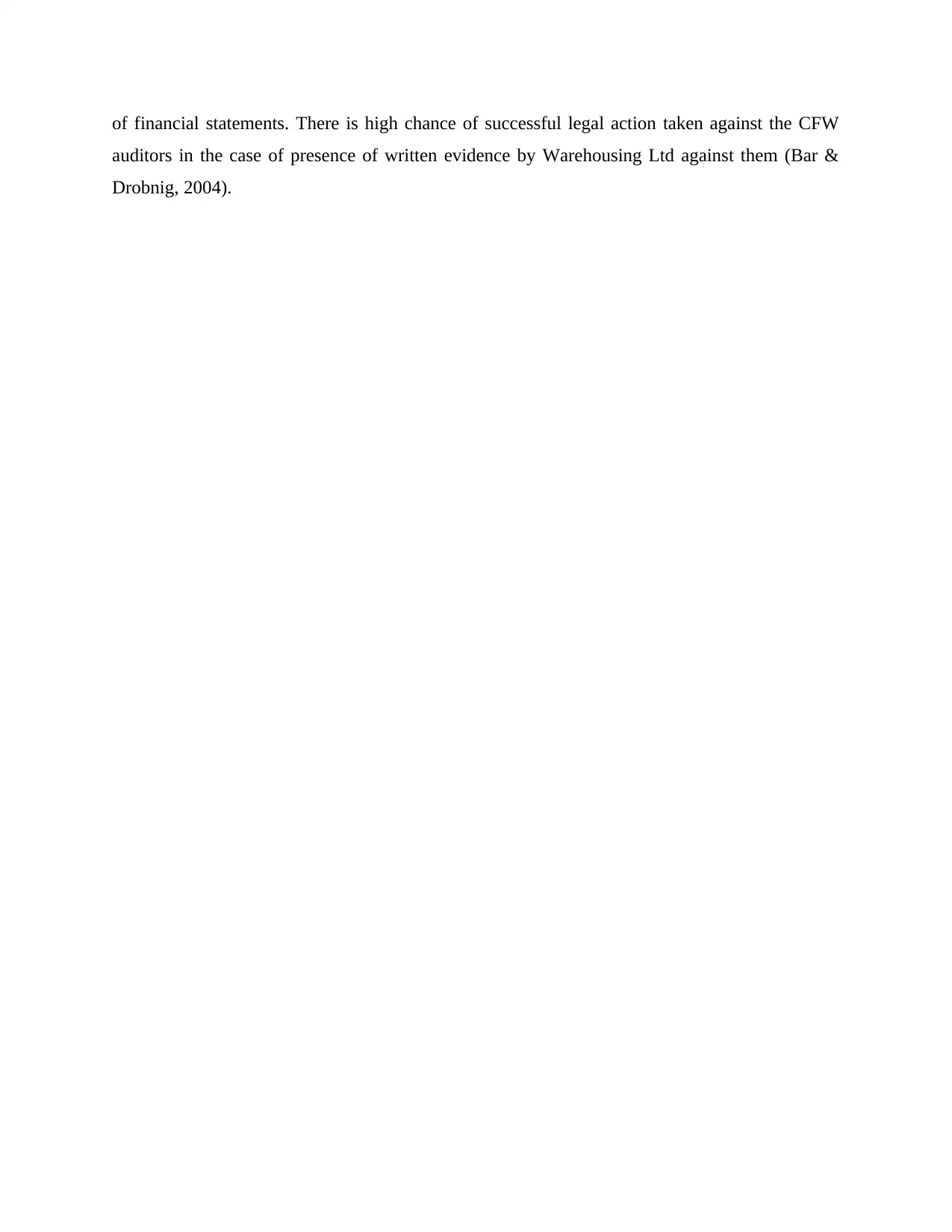
of financial statements. There is high chance of successful legal action taken against the CFW
auditors in the case of presence of written evidence by Warehousing Ltd against them (Bar &
Drobnig, 2004).
auditors in the case of presence of written evidence by Warehousing Ltd against them (Bar &
Drobnig, 2004).

References
Bar, C. & Drobnig, U. (2004). The Interaction of Contract Law and Tort and Property Law in
Europe: A Comparative Study. sellier. european law publ.
Bellassen, V. & Stephan, N. (2015). Accounting for Carbon. Cambridge University Press.
International Standard on Assurance Engagements. (2012). Retrieved 31 March, 2018, from
https://www.aicpa.org/Research/Standards/AuditAttest/ASB/Documents/Mtg/1207/ISAE
%203410-Final%206-6-12.pdf
Tritschler, J. (2013). Audit Quality: Association between published reporting errors and audit
firm characteristics. Springer Science & Business Media.
Woodside Petroleum Ltd. (2016). Sustainable Development Report. Retrieved 31 March, 2018,
from http://www.woodside.com.au/Investors-Media/announcements/Documents/
16.03.2017%202016%20Sustainable%20Development%20Report.pdf
Maintaining your registration as an auditor. (2018). Retrieved 31 March, 2018, from
http://www.cleanenergyregulator.gov.au/Infohub/Audits/information-for-auditors/
maintaining-your-registration-as-an-auditor
AICPA. 2017. Audit and Accounting Guide: Gaming 2017. John Wiley & Sons.
Zahar, A., Peel, J. & Godden, L. (2012). Australian Climate Law in Global Context. Cambridge
University Press.
Agl Sustainability Report. (2016). Retrieved 31 March, 2018, from http://agl2016.sustainability-
report.com.au/system/files_force/downloads/agl_csr_2016.pdf
Auditor Liability. (2018). Retrieved 31 March, 2018, from
http://www.accaglobal.com/in/en/student/exam-support-resources/professional-exams-
study-resources/p7/technical-articles/auditor-liability.html
Bar, C. & Drobnig, U. (2004). The Interaction of Contract Law and Tort and Property Law in
Europe: A Comparative Study. sellier. european law publ.
Bellassen, V. & Stephan, N. (2015). Accounting for Carbon. Cambridge University Press.
International Standard on Assurance Engagements. (2012). Retrieved 31 March, 2018, from
https://www.aicpa.org/Research/Standards/AuditAttest/ASB/Documents/Mtg/1207/ISAE
%203410-Final%206-6-12.pdf
Tritschler, J. (2013). Audit Quality: Association between published reporting errors and audit
firm characteristics. Springer Science & Business Media.
Woodside Petroleum Ltd. (2016). Sustainable Development Report. Retrieved 31 March, 2018,
from http://www.woodside.com.au/Investors-Media/announcements/Documents/
16.03.2017%202016%20Sustainable%20Development%20Report.pdf
Maintaining your registration as an auditor. (2018). Retrieved 31 March, 2018, from
http://www.cleanenergyregulator.gov.au/Infohub/Audits/information-for-auditors/
maintaining-your-registration-as-an-auditor
AICPA. 2017. Audit and Accounting Guide: Gaming 2017. John Wiley & Sons.
Zahar, A., Peel, J. & Godden, L. (2012). Australian Climate Law in Global Context. Cambridge
University Press.
Agl Sustainability Report. (2016). Retrieved 31 March, 2018, from http://agl2016.sustainability-
report.com.au/system/files_force/downloads/agl_csr_2016.pdf
Auditor Liability. (2018). Retrieved 31 March, 2018, from
http://www.accaglobal.com/in/en/student/exam-support-resources/professional-exams-
study-resources/p7/technical-articles/auditor-liability.html
Paraphrase This Document
Need a fresh take? Get an instant paraphrase of this document with our AI Paraphraser


1 out of 12
Related Documents
Your All-in-One AI-Powered Toolkit for Academic Success.
+13062052269
info@desklib.com
Available 24*7 on WhatsApp / Email
![[object Object]](/_next/static/media/star-bottom.7253800d.svg)
Unlock your academic potential
© 2024 | Zucol Services PVT LTD | All rights reserved.





